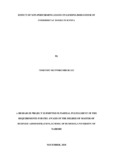| dc.description.abstract | The size and quality of loan book is a concern for each and every commercial bank. The quality of loan’s book for each bank is determined by the size of total non-performing loans. Commercial banks therefore wish to give out loans as much as possible, but they need to give loans to individuals, institutions or other clients that would be in position and at the same time willing to repay the loans together with interest as and when they fall due. The banks are therefore faced with a challenge of vetting all potential borrowers, and ensuring that they obtain enough security that would caution them against clients who would fail to honour their obligations when they fall due. The banks therefore aspire to issue loans but at the same time ensure that they have the minimum possible non-performing loans. It is with this knowledge that the researcher set out to look on non-performing loans and the possible effect on lending behaviour of commercial banks in the country. The study construed that loan managers are under pressure to issue loans, on the other hand they are required to issue quality loans in which recovery of the same loan would be easier and less costly. This scenario was modelled in the form of a multiple linear regression model that was used to describe the effect of non-performing loans on lending behaviour. The study used descriptive research design and secondary data collection methods employed to collect data for the various variables that were studied in the form of total gross non-performing loans, capital adequacy ratio, firm size and inflation rate that acted as control variables. Their effect on lending behaviour that was represented by the total loans issued over total assets of the bank was determined for a period of 5 years (2013-2017). SPSS version 20 was used to analyse the variables at 95% degrees of freedom, where F statistic test was used to test for significance of the model. Data from 20 banks for 5 years was obtained and analysed accordingly. The regression model that ensued had a coefficient of determination of 20.4% that showed a weak model that was used to predict the dependent variable. The null was however rejected as the F calculated was greater than F critical. The study was also significant at 95% degrees of freedom as it showed that there was positive significant effect of non-performing loans on lending behaviour. The study suggested that increase in non - performing loans resulted from increase in lending behaviour. The conclusion of the study was that in order to ensure that there is accountable total non-performing loans, then banks would need to have a check on their lending behaviour. | en_US |



